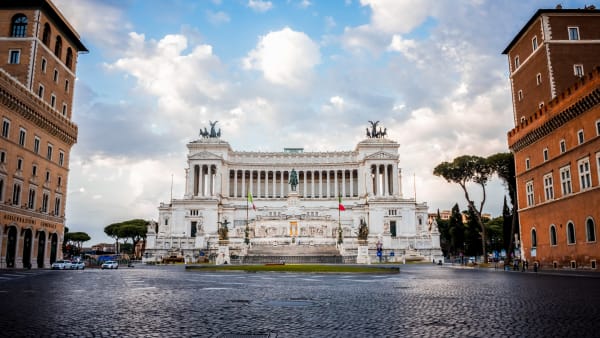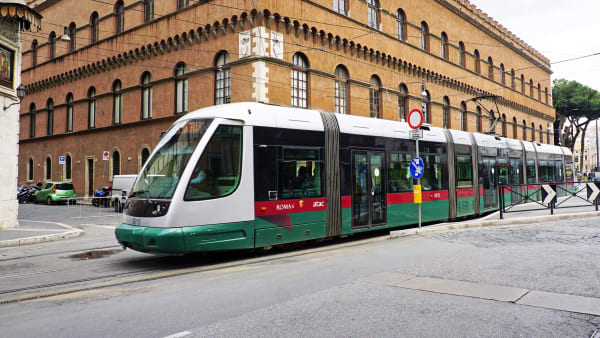Curiosities
Curiosities
Did you know that in theory, the victory over Maxentius didn’t meet the requirements to have a triumphal arch built? After all, this was a war between two Roman emperors in which the blood of their own people had been spilled. Probably because Maxentius was seen as an evil ruler and enemy of the empire, the construction of the arch was justified.
Read on to discover more facts about the Arch of Constantine!
A revolutionary monument
When looking at the style of the sculptures from the era of Constantine, you can see how different the carving is compared to the rest of the monument. Whereas the panels that had been borrowed from earlier monuments (from the era of Marcus Aurelius) are so classical, the figures telling the story of Constantine are the opposite.
However, some art historians now conjecture that Constantine’s imagery isn’t meant to compete stylistically and that it was valued for its clarity. The lack of concern for the correct proportions of the human body, the lack of interest in space for bodies to exist in, are characteristics that we associate with early Christian art, meant to function symbolically rather than naturalistically.
The shift away from Greek naturalism facilitated the interpretation of the figures. As mentioned earlier, for some, this was a sign of decadence and a farewell from the tradition of Hellenistic Roman art, which had been deeply assimilated by the Roman upper class since the mid-Republican period.
For others, it’s an artistic interpretation of the Romanized provinces and a greater naturalness; but also a sign of the emergence of new artistic styles that would become more pronounced in later eras, making way for abstract art.
Either way, the elements of the Constantinian period drastically broke away from traditional Roman art. The monument, therefore, refers, on the one hand, to the time before Constantine, when Christianity was not yet officially tolerated, with literally thrown together pieces of remains from other monuments, and on the other hand, the beginning of a Christian millennium, full of symbols and with a simpler art form.
The controversial inscription
The much-discussed inscription on the arch was made by the Senate to gain favor with the new emperor and to celebrate the defeat of the tyrant Maxentius.
The attic inscription in Latin states as follows:
“IMP(eratori) CAES(ari) FL(avio) CONSTANTINO MAXIMO P(io) F(elici) AUGUSTO S(enatus) P(opulus) Q(ue) R(omanus) QUOD INSTINCTU DIVINITATIS MENTIS MAGNITUDINE CUM EXERCITU SUO TAM DE TYRANNO QUAM DE OMNI EIUS FACTIONE UNO TEMPORE IUSTIS REM PUBLICAM ULTUS EST ARMIS ARCUM TRIUMPHIS INSIGNEM DEDICAVIT”.
And means:
“To the Emperor Caesar Flavius Constantinus, the greatest, pious, and blessed Augustus: because he, inspired by the divine, and by the greatness of his mind, has delivered the state from the tyrant and all of his followers at the same time, with his army and just force of arms, the Senate and People of Rome have dedicated this arch, decorated with triumphs”.
In particular, the phrase “by divine inspiration” has raised many questions and debates among scholars who, without reaching a common conclusion, emphasize that one can recognize in that term formulations that belong to both Christian and pagan culture.
The inscription on the triumphal arch indicates with this wording that Constantine considered the victory at the Milvian bridge to be the result not only of his military, political, and strategic genius but also of the supernatural support he received.
Constantine and Christianity
Referring to the above inscription, some historians claim that the only (pagan) gods the monument refers to are the sun god Apollo and the moon goddess Diana. But as mentioned earlier, these symbolize the greatness and divinity of Constantine himself.
The historian Eusebius of Caesarea, on the other hand, claims that the emperor overwhelmingly embraced the monotheistic Christian religion. After all, he believed that with the help of God he had won the battle against Maxentius. Moreover, with the Edict of Milan in 313, Constantine recognized the freedom of religion, which made Christianity a legitimate religion in the Empire.
Despite the above claims, Constantine didn’t take sides until the end of his life as he converted to Christianity on his deathbed. From this, it can be concluded that the real strength of Constantine was his ability to convey a series of concrete messages, which were seemingly contradictory, as they focused on his goal of uniting the many people within the Empire and thus the political and social components of the time.
Constantine and Sol Invictus
Despite being known as the first Christian emperor of the Roman Empire, Constantine worshiped the sun god Sol Invictus, the “Unconquered Sun,” from his early years. This cult and religion didn’t officially exist until 274 AD and was very similar to early monotheistic Christianity. Reason being that Sol and God were both sources of heavenly light and victory.
According to historians, Constantine had a special relationship with Sol Invictus. Thus, in 310, coins were increasingly minted with the busts of Constantine as well as the sun god. The distribution of personalized coins throughout the Empire was an important means of communicating imperial power, legitimacy, and ideas to the people.
These coins also bore the inscription “SOLI INVICTO COMITI” (Sol, invincible companion). Combined with the type of coins that figuratively feature Constantine and Sol together, the inscription emphasizes that the emperor had chosen Sol as his companion and patron saint.
A special coin was also struck after Constantine’s death. This one contains a quadriga symbol that can be linked to the Sol Invictus, the same one depicted on the Arch of Constantine. In other words, even after the emperor’s death, it was decided not to strike Christian symbolism on Constantine’s coins.
The Meta Sudans
In 1936, it was decided to demolish a monument located near the Colosseum and the Arch of Constantine, the Meta Sudans. It was built around the year 80 by order of Emperor Titus and was completed by Domitian. The fountain stood at the intersection of four city districts, at the place where Via Triumphalis crossed Via Sacra. To avoid traffic obstructions between the Colosseum and the Roman Forum, it was removed.
The Meta Sudans was made of concrete and brick and was conical in shape, much like the turning posts (metae) on the spina of a Roman circus. Sudans means “sweating” and refers to the water that seemed to slide down the marble walls of the fountain like sweat.
The appearance of the monument has been superseded because it’s depicted on ancient coins. It’s estimated that the fountain must have been 17 m high and had a diameter of 25.5 m. In addition, arcades with statues were placed, possibly on the occasion of the construction of the Arch of Constantine.
According to an ancient legend, gladiators went to the fountain after their battles to wash and quench their thirst. The remains of the Flavian fountain were eventually dismantled during the fascist era when the Via dei Trionfi (triumphal route) was constructed.
Other Roman Arches
Besides the Arch of Constantine, the Arch of Titus and the Arch of Septimius Severus are also in good condition today. The former is the monumental entrance to the Forum Romanum and was built in honor of the emperor’s victory over Judea in 70 AD. It was built by the Senate in memory of Emperor Titus after his death in 81 AD.
With its simplicity, noble proportions, and sculptural decoration, the arch is a wonderful example of austerity and balance. The reliefs within the Arch of Titus depict the two highlights of the triumphal march and are considered the highest expression of the illusionistic style in Roman sculpture.
The second was built in 203 AD by order of the Senate in honor of Emperor Septimius Severus and his sons Caracalla and Geta. The inscription on the monument refers to two glorious deeds of Septimius Severus that marked the first years of his reign.
The beauty of the architectural proportions, which made the Arch of Septimius Severus a paragon, is outweighed by the lavish sculptural decoration, which depicts scenes of the emperor’s military campaigns in the East and the tributes of the peoples he had subjugated.
Also still standing is the Arch of Janus, a quadrangular structure between the Tiber and the Roman Forum. The monument was built around 356 AD by order of Emperor Constantius II in honor of his father Constantine the Great. The original name of the arch was Arcus divi Constantini (arch of the deified Constantine). After Roman times, it was named Janus, the god of gates and bridges.
But these were not the only arches in Rome. According to the registers of the 14 regions of Augustinian Rome there were as many as 36. Some were smaller or lesser-known than the above and others have since disappeared. A few examples are the Arch of Pompey (61 BC), the Arch of Drusus (9 BC), the Arch of Nero (62 BC), and the Arch of Marcus Aurelius (176 AD).















